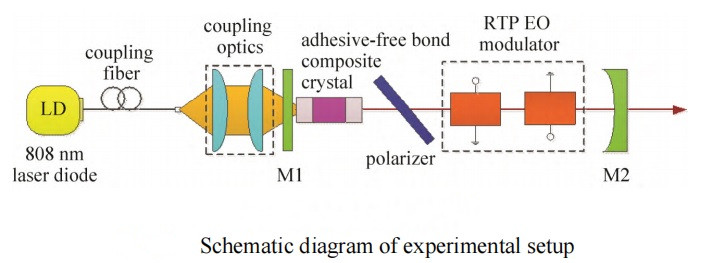1.3 Laser Gain Medium
At present, in all solid-state E-O Q-switched lasers, the commonly used gain media of 1 μm laser wavelength are Nd:YAG (www.wisoptic.com), Nd:YVO4, Nd:GdVO4, Yb:YAG and Nd:YLF, etc. Gain media commonly used at other laser wavelengths include Er:YAG, Tm:YAP and Tm:YAG. The upper fluorescence lifetime of Nd:YAG and Er:YAG is 230 μs, and that of Nd:YLF is 485 μs, and the upper fluorescence lifetime of Tm:YAP and Tm:YAG is 485 μs. The fluorescence lifetime of the upper level is 4.4 ms and 13.9 ms, respectively. The longer fluorescence lifetime of the upper level limits the improvement of the repetition rate of the E-O Q-switched laser. However, Nd:YVO4 and Nd:GdVO4 have a short upper level fluorescence lifetime (90 μs) and are often used in high repetition rate E-O Q-switched lasers. In addition, Nd:YVO4 and Nd:GdVO4 have larger excitation cross section and higher pump absorption coefficient, which makes higher gain laser output under high repetition rate operation.
In 2011, KIM J W et al. used 1 532 nm in-band pumped Er:YAG and RTP (www.wisoptic.com) Pockels cell to make laser output with maximum single pulse energy of 30.5 mJ and pulse width of 20 ns, the repetition rate was 20 Hz. Repetition rate 30 Hz gives single pulse energy of 23 mJ and pulse width of 53 ns. At repetition rate of 2.5 kHz, a 1 617 nm laser output with single pulse energy of 4.5 mJ and a pulse width of 110 ns was obtained.
In 2012, CHANG L et al. first used 885 nm end-pumped Nd:YAG and BBO Pockels cell to make laser output with maximum single-pulse energy of 5.1 mJ and shortest pulse width of 14.5 ns while the repetition rate is 2 kHz. At repetition rate of 10 kHz, the laser output of 1 064 nm with a maximum average output power of 22.7 W was obtained.
In 2012, Liu Rui et al. used bonded crystal Nd:YVO4 + Nd:GdVO4 as the laser gain medium and RTP Pockels cell in their comparative experiments. Both lasers could obtain the base transverse mode output with highest repetition rate of 150 kHz. The experimental results show that the Nd:YVO4 crystal with larger emission cross section is easier to be operated under the condition of E-O Q-switching with high repetition rate at low pump power. Compared with the composite Nd:YVO4 crystal, the composite Nd:GdVO4 crystal with better thermal conductivity is easier to obtain high repetition rate laser output at high pump power. The schematic diagram of this experimental is shown in figure below.
Post time: Oct-14-2022

